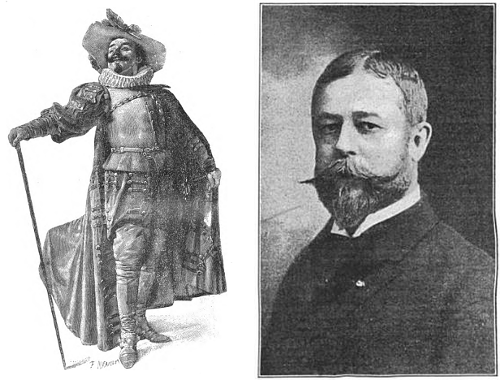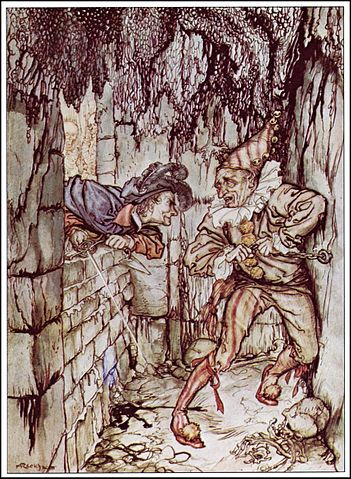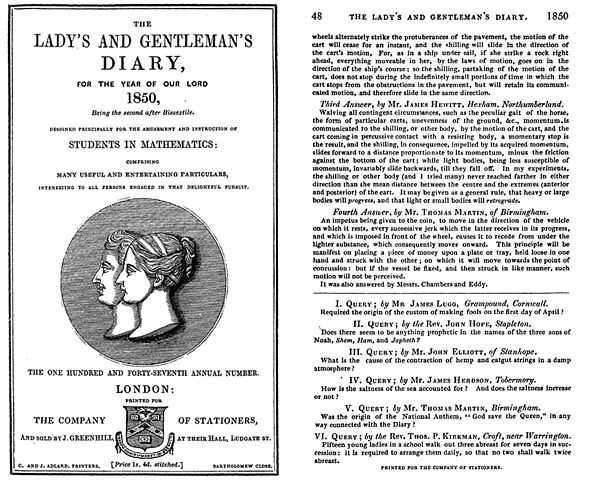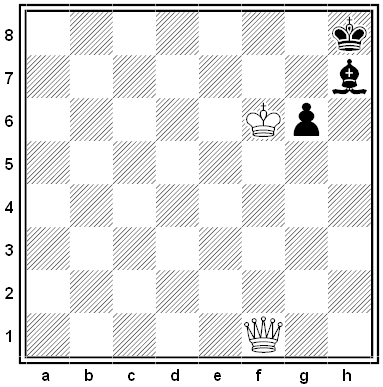You’re on a drug regimen that requires you to take one pill a day from each of two bottles, A and B. One day you tap one pill into your palm from the A bottle and, inadvertently, two pills from the B bottle. Unfortunately the A and B pills are indistinguishable, and taking more than one B pill per day is fatal. And the pills are very expensive, so you can’t afford to throw out the handful and start over. How can you arrange to take the correct dose without wasting any pills?
Podcast Episode 65: The Merchant Prince of Cornville

Edmond Rostand’s hit play Cyrano de Bergerac met an unexpected obstacle in 1898 — a Chicago real estate developer who claimed that it plagiarized his own play. In this week’s podcast we’ll review the strange controversy and the surprising outcome of the lawsuit that followed.
We’ll also hear an update on the German author who popularized an American West that he had never seen and puzzle over a Civil War private who refuses to fight.
In a Word

obstaculous
adj. of the nature of an obstacle
sufflaminate
v. to put an obstacle in the way of; to obstruct
intermure
v. to enclose between walls, to wall in
circummure
v. to wall round
Taber Bills
In 1799, Massachusetts passed a law restricting private banking companies from issuing their own currency notes without the consent of the legislature. This was well intended: If unlimited paper money were allowed to circulate, the resulting inflation would play havoc with the finances of ordinary people.
Unfortunately, the result was that legitimate currency became harder and harder to find. In Maine, where only a single bank existed, people were increasingly desperate for currency, and so the Portland merchant John Taber began to circulate notes for 1, 2, 3, and 4 dollars, payable to the bearer in silver on demand, despite the law:

This worked for a while, propped up by Taber’s reputation. But Taber’s profligate son Daniel began to print bills for his own use as he needed them, and when Massachusetts repealed its law John Taber and Son were forced into bankruptcy.
When it was over, Taber approached his old partner Samuel Hussey, who owed him $60. Hussey invited him into his counting room, counted out the amount in Taber’s own now-worthless bills, and asked for a receipt.
Taber said nervously, “Now, thee knows, friend Hussey, this money is not good now.”
“Well, well, that is not my fault,” said Hussey. “Thee ought to have made it better.”
(From the Collections and Proceedings of the Maine Historical Society, 1898.)
Two-Timing
The square root of 2 is 1.41421356237 … Multiply this successively by 1, by 2, by 3, and so on, writing down each result without its fractional part:
![]()
Beneath this, make a list of the numbers that are missing from the first sequence:

The difference between the upper and lower numbers in these pairs is 2, 4, 6, 8 …
From Roland Sprague, Recreations in Mathematics, 1963.
Kirkman Schoolgirls Problem

“Fifteen young ladies in a school walk out three abreast for seven days in succession: it is required to arrange them daily, so that no two shall walk twice abreast.”
The Rev. Thomas Penyngton Kirkman posed this query innocently in The Lady’s and Gentleman’s Diary in 1850. It’s trickier than it looks — though seven solutions are possible, they’re difficult to discover by trial and error. Here’s one:

Each letter appears once in each row, but no two letters share a cell more than once. The problem’s simplicity made it popular among Victorian amateur mathematicians, and Kirkman later complained that it had eclipsed his more serious work — though he took pains to dispute James Joseph Sylvester’s claim to have invented the problem himself.
Do such problems generally have solutions? Surprisingly, the answer remained unknown until just last January, when Oxford mathematician Peter Keevash showed that the answer is yes if certain basic requirements are met. Keevash’s result was “a bit of an earthquake as far as design theory is concerned,” said Cambridge mathematician Timothy Gowers.
Now that the schoolgirl problem is under control, a related challenge has taken its place. If 20 golfers want to arrange themselves into different foursomes on five successive days, is it possible to plan the groups so that each golfer plays no more than once with any other golfer? Formally the “social golfer problem” remains unsolved — though tournament organizers work out individual solutions every day.
(Thanks, Martha.)
Law and Punctuation
In Ward v. Ward, a North Carolina court’s entire finding rested on the presence of a single comma. The will of Alvin T. Ward read:
My Trustee is directed to pay such amounts of and from the income generated by said trust, and from the principal of said trust if he deems same to be advisable, to, for, or on account of my said wife in quarterly installments or more frequently if he deems advisable and if practicable.
Is the trustee required to pay the income to Ward’s wife, or can he use his discretion? The income payments are required, ruled the court: The comma after “said trust” shows that only the distribution of the principal is left to the trustee’s judgment.
In Henderson v. State, Jacob Henderson’s 1984 burglary conviction in Mississippi was reversed in part because of a misplaced period:
The Grand Jurors for the State of Mississippi, … upon their oaths present: That Jacob Henderson … on the 15th day of May, A.D., 1982.
This is a “non-sentence,” noted the court. “The unmistakable period after 1982 is used by astute defense counsel to nail down the point — that the indictment fails to charge that Jacob Henderson did anything on May 15, 1982.” (This whole indictment is a notorious trainwreck.)
And in People v. Vasquez, a New York court disregarded an affidavit and dismissed a complaint because a misplaced comma made it unclear whether a key affidavit was hearsay:
“It may be that the confusion [about the affidavit] arises from the typographical error of placing a comma before the expression ‘upon information and belief,'” wrote the court. “Had the comma not existed, the entire expression ‘and that the assertion upon information and belief’ would have referred back to the earlier mentioned accusatory instruments so as to render the affidavit non-hearsay.”
Hour of Babel

A problem from the second Balkan Mathematical Olympiad, 1985:
Of the 1985 people attending an international meeting, no one speaks more than five languages, and in any subset of three attendees, at least two speak a common language. Prove that some language is spoken by at least 200 of the attendees.
Black and White
Podcast Episode 64: Murder at the Priory

In 1876 London was riveted by the dramatic poisoning of a young barrister and the sordid revelations that emerged about his household. In today’s show we’ll review the baffling case of Charles Bravo’s murder, which Agatha Christie called “one of the most mysterious poisoning cases ever recorded.”
We’ll also get an update on career possibilities for garden hermits and puzzle over how the police know that a shooting death is not a homicide.


